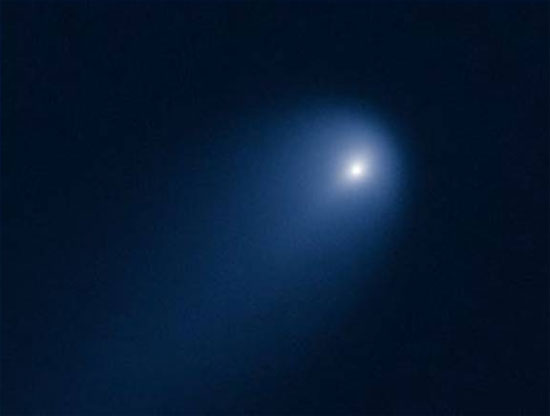Comet detection is the brightest century
The Hubble Space Telescope has just found a comet capable of becoming a bright object like the moon in November.
>>>The extremely special comet will appear in 2013
Hubble took the first close-up picture of ISON, the name of the comet, on the evening of April 10 - when comet was about 630 million kilometers from Earth, National Geographic reported.

The brightness of the ISON comet will be equivalent
moon at the end of November. (Photo: National Geographic)
Currently, if observing ISON with large telescopes, people only see a very dim light. But astronomers predict that it will glow like the moon in the night sky at the end of November this year. So they call it the " comet of the century ".
Based on data from Hubble, astronomers believe that Comet ISON - which is a dirty block of ice - has a width of 4.8 to 6.4 km. Its tail is nearly 5,000 km in diameter.
In the latest photo taken by Hubble's glass, ISON is a streak of dust flying away from the sun. Its length is more than 91,200km. Since ISON flew towards the sun in the next few months, its ice-filled surface would continue to melt. The heat from the sun thawed in the core, turning them into dust and gas streaks. The closer the comet approached the sun, the thicker and wider the streaks were.
Astronomers believe this is the first time ISON has flown from outside to the center of the solar system. Based on its trajectory, they believed that the attraction of the sun would make ISON close to the sun on November 28. It will fly more than a million kilometers from the sun before bouncing off the edge of the Solar System.
- Century comets
- The comet of the century will not light
- The new comet is approaching the sun
- Spectacular new image of the comet of the century
- McNaught - the brightest comet in the past 30 years
- Comet ISON only has dust left
- The ISON comet can be observed with the naked eye
- The brightest blue comet in the sky rushes towards Earth
- Video: Comet hit the sun
- Comet 'century' approaches the Earth
- Century comet directs the sun
- The 1,000th comet detection belongs to the Kreutz group
 Van Allen's belt and evidence that the Apollo 11 mission to the Moon was myth
Van Allen's belt and evidence that the Apollo 11 mission to the Moon was myth The levels of civilization in the universe (Kardashev scale)
The levels of civilization in the universe (Kardashev scale) Today Mars, the sun and the Earth are aligned
Today Mars, the sun and the Earth are aligned The Amazon owner announced a secret plan to build a space base for thousands of people
The Amazon owner announced a secret plan to build a space base for thousands of people